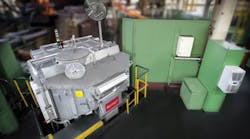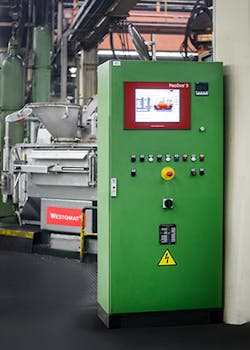Cologne Tool and Die is a Ford Motor Co. subsidiary in Germany that, in addition to manufacturing (and repairing) stamping tooling and dies produces aluminum diecastings for automotive transmissions and engines. Aluminum is melted in and poured from a series of StrikoWestofen dosing furnaces. A recent effort to improve the furnaces’ productivity and availability, and to reduce energy consumption, is being credited to a reline and process control system revamp.
After two years of reliable operation, the Ford operation saw a lot of potential for improvement in the Westomat dosing furnaces. Several of the units had been modernized in recent years, to the operators’ satisfaction.
For that reason, it contracted StrikoWestofen to overhaul six more of the units. The customized revamp project set out to improve dosing accuracy, reduce energy consumption, and increase system availability.
“Thanks to the rapid completion of the work, we had practically no production downtime,” commented Ford’s diecasting maintenance manager Klaus Herweg. The replacement of older Westronics control systems by the new ProDos 3 was the first step toward increasing productivity.
The ProDos3 system uses constant analysis of the process flows, thus “intelligently” adapting the dosing procedure of the Westomat to the production cycle in each case. In this way, it increases dosing accuracy by up to 35%, which makes an important contribution to reducing the volume of return metal. It also makes the furnaces easier to operate, too. “Over the last three years, we have had seven of our dosing furnaces converted,” Herweg explained. “We also installed an additional new system as part of the general overhaul of a diecasting machinery.”
Depending on maintenance and use of the Westomat furnace, relining sooner or later is an unavoidable step. Furnace developer StrikoWestofen offers three alternatives to Westomat operators, depending on their availability and/or tolerance for furnace downtime. The first is relining at the developer’s location in Gummersbach, Germany, which takes about 4 to 5 weeks to complete, including transport to the factory and back.
A second, more timesaving option is to remove the furnace from the plant site and replace it with a pre-sintered, relined replace system. This involves just five working days of downtime, including the heating-up phase.
The third option, for those metalcasting operations where production time is of maximum importance, a relined replacement furnace body is recommended. Even with the heating-up phase, this alternative requires no more than three working days of downtime, according to StrikoWestofen.
Ford decided to have relining carried out directly at the StrikoWestofen location. Delivery with new, completely dried linings ensured rapid commissioning of the dosing furnace and made it unnecessary to process “rinsing” batches once they were restarted. For one furnace, the customer decided to have a complete replacement furnace body delivered, which allowed for “especially rapid re-commissioning” according to the contractor. Once the relining was completed, even the other, older Westomat furnaces matched the performance of the newer models. Modern insulation materials allow them to keep up with comparable new systems in terms of energy consumption, according to the furnace designer. For Ford, the revamping costs (due to furnace availability and reduced energy consumption) will be recovered within a few months of operation.
StrikoWestofen offers several made-to-order modernization concepts to its customers, from relining to complete modernization, including control, switching system, pneumatics, sensors, and cabling. It is also possible to retrofit many of the new options introduced since the initial furnace installation into existing systems: such as riser tube edge cleaning, a self-cleaning transfer launder, a flanged riser tube, biscuit correction, increased dosing accuracy, Webserver 4.0, and others. “Conversion to ProDos 3 as well as relining were worthwhile investments,” according to Herweg. “New is not necessarily better, after all!”










